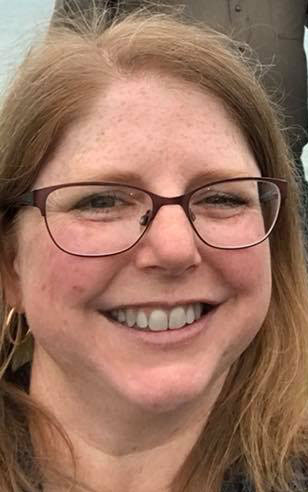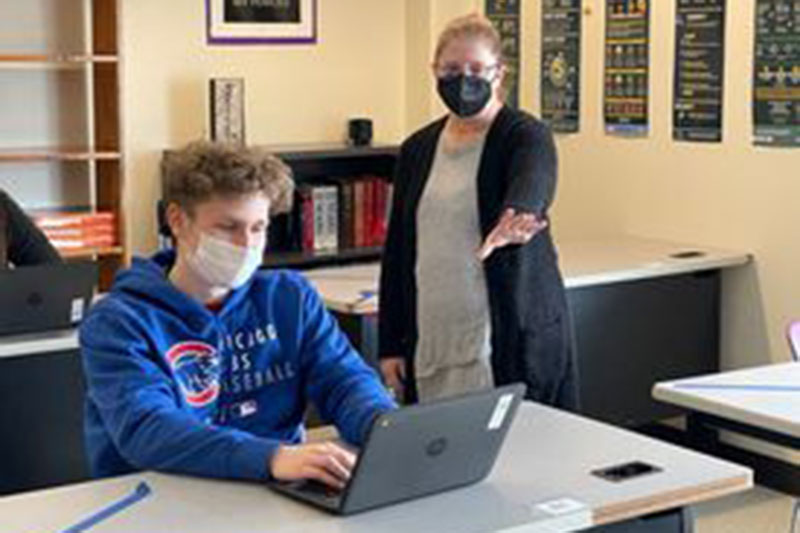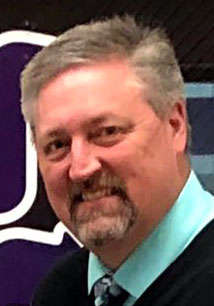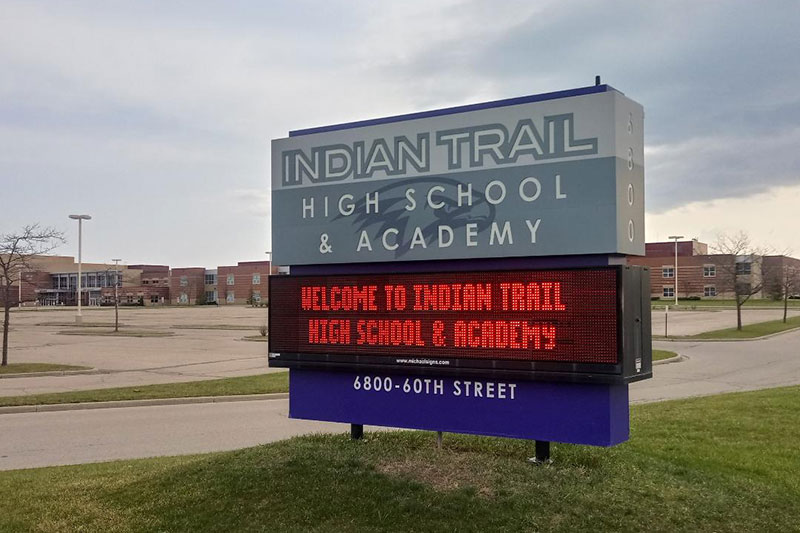Pour a cup of coffee and pull up a chair. Just reading about the daily life of Indian Trail High School instructional technology teacher Page Kessler is exhausting.
While that statement certainly applied to Kessler’s 32-year career well before the term “virtual learning” was common vocabulary, nothing could compare to the whirlwind that arrived March 13, 2020 when schools first went virtual, and hasn’t let up since.
“Every day is very different, always challenging and rewarding,” Kessler said. “Occasionally, a difficult situation regarding application of technology or digital tools occurs, and we have to rise to the expectation that we can find a solution for students and staff to overcome the challenges.”

Kessler has been at Indian Trail since 1998, shepherding the school through its journey as an early adopter of technology to the largest rollout of tech in district history. ITHS principal Scott Kennow credits Kessler with being the key to an incredibly complex operation.
“Page sits at the center of everything instructional that takes place in our school, especially when it comes to programs, hardware and software,” Kennow said. “She wears many, many hats. She is the ultimate team player and my staff sees her as a critical resource and support.”
Kessler took time out of her jam-packed schedule to give us a glimpse into a day in the life of a tech whiz in arguably the city’s busiest high school.
Sunrise
Not counting the emails that stream in at all hours, Kessler’s day starts prior to 7:15 a.m. with troubleshooting.
“I’m putting out classroom fires, issues with tech, issues with student connections and devices and substitutes getting settled,” Kessler said “My primary function at the beginning of the day is to help support staff with instruction and making sure all of their resources are working correctly.
“From there life is a blur.”
Kessler described her day as a series of “sprints and marathons” depending on the teachers’ plans and the learning cycle timelines. She schedules drop-ins throughout the day for problem-solving or a quick “how-to,” but also works in coaching cycles with staff utilizing their digital resources for instruction.
She works with students in the same capacity, teaching such things as how to create video clips for a project, or how to best utilize color on presentations.
“I refer to my job as the ‘use it’ portion of instructional technology,” Kessler said.
8 a.m.
Once the day gets going and everyone appears to have their problems resolved, Kessler shifts gears for weekly tech meetings. Even something as routine as a meeting becomes an obstacle course with mountains of responsibilities, schedule crunches and at least a few curveballs along the way.
During a recent meeting with the principal and technology support technicians, the team had to tackle a laptop update of assigned devices for 120 business students, standardized testing support. They also navigated the arrival and installation of 30 Promethean panels and 65 new document cameras, “replacing the model that does not really work within this hybrid model due to age,” Kessler said.
“In the middle of the meeting we received an SOS from a teacher whose WiFi dropped in her classroom, and all of her students in-person lost WiFi as well,” Kessler said. “Our first priority was to get her back online before we could continue.”
When the meeting resumed, the team coordinated an effort between district tech support and ITHS to shift from local file storage within KUSD to cloud file storage, with a timeline of one month to get all of the staff at the school transitioned.
Kessler also squeezed in prep for mid-term grades in the district’s Infinite Campus system in coordination with Parent-Teacher conferences, and a meeting about supporting another district project.
9:30 a.m.
Late morning brought Kessler from the administrative side back to her role as troubleshooter-in-chief. She received a message from a staff member who was trying to work with email more efficiently, which somehow resulted in all of her email going in the trash.
“That was creative, yet not what she was looking for,” Kessler said. “Now she could not reverse or correct the issue. I deleted the rule she accidentally applied, and it was all better.”
After saving that teacher’s sanity, Kessler reviewed and worked on budget pricing for a new course next year that requires specific software and access. She then pulled together a proposal for the teacher to include this technology in the cost of the class implementation.
Certainly, that all sounds like a full day’s work, but Kessler was just getting started.
11 a.m.
Kessler’s title includes “teacher,” and she lives up to that not only by instructing staff and students about the best way to utilize technology, but also by making teaching come to life.
An Indian Trail personal finance class wanted to collaborate using a Jamboard (an interactive whiteboard that is part of Google Workspaces) for a problem-solving activity. The teacher needed to monitor both online and in-person student application, collaboration and peer critique of IRA, Roth IRA and pension-planning content. With one visit, Kessler provided a quick lesson for the students on how to monitor Jamboards using frames view. She then sped off to put out technology fires, then stopped back in at 1 p.m. for the personal finance students’ presentations.
“The way Page communicates is so important.”
– Scott Kennow, Indian Trail principal on Page Kessler
“It was a great activity with true engagement and collaboration,” Kessler said. “The teacher and students felt confident about their knowledge of IRA, Roth IRA and mutual funds in connection with retirement and pensions, and as a side note they are all much more comfortable using Jamboards.”
Multi-tasking while multi-tasking seems to be Kessler’s specialty. At the same time she was facilitating the personal finance class, Kessler and her team took on a slate of tech issues that ran the gamut from routine student tech issues and teacher gradebooks to troubleshooting glitches in a staff meeting on Google meet. Ironically, that meeting was a professional development on the best way to make a meeting flow.
“The way Page communicates is so important,” Kennow said. “It’s not always the ‘what’ but the ‘how.’ She knows when to use humor and when to take a big sledgehammer out, and she’s almost always spot on.”
Noon
Lunch? It wasn’t on the menu yet.
Kessler stopped into a self-contained special education classroom to help the occupational therapist set up a hybrid lesson using the Promethean panel and a laptop. Another issue occurred that sent Kessler running to another classroom to provide a fix so the teacher could continue her lesson. Students didn’t miss a minute of instruction.
1:30 p.m.
The afternoon started with a study in contrasts. First, Kessler worked with secretaries on their mega-transition from their traditional network drive to cloud storage. She then switched gears to meet with her tech team to brainstorm ways to assist families.
“We discussed a couple students who are struggling with connectivity at home and how to best use devices to have the smallest footprint,” Kessler said.
Kessler went “old school” to complete that process when she made a phone call to one of the students to test a possible solution.
“I have a lot of kids who email me. I get emails all day long and all night that say, ‘Hey Ms. Kessler, I know you’re probably sleeping, but if you get this email, I’m working on this and I’m having a problem,’” Kessler said. “We jump on meets on Saturdays and Sundays to help kids as well. It’s all part of our job. We have to support our clients who are our students first, and then our staff and then ourselves. It’s really important.”
2 p.m.
Like most late afternoons, Kessler found herself back where she started, answering email questions, checking what would be needed for the next day, and anticipating emergencies in the morning. On this particular day, that meant setting up tech for teachers who needed subs, planning for a meeting on standardized testing logistics and finalizing room surveys for Promethean installs.
3 p.m.
Time for one last round of daily troubleshooting. Kessler “rehearsed” with Kennow and an instructional coach for the upcoming staff meeting, working to resolve laptop lag issues in time for the meeting to begin.
Kessler doesn’t ask for much, but after busy days like this one, she does have one big request: A clone.
“There’s not enough of me in the building. Sometimes feel like I need a clone,” Kessler said. “I have several teachers who have stepped up and once they were comfortable took over some of the troubleshooting for products in their departments. They check in with me often and are helping with the smaller issues, so our team can focus on the larger ones.”

Sundown
The school day was over, but Kessler’s was not. After returning home to grab dinner, she typically gets back on email to assist staff with questions and requests for assistance.
“I appreciate that the weather is getting nicer now. I have fewer night emergencies,” Kessler said. “When this first began, it was common last March through June to be online until 10:30, 11 p.m. working with staff. Many have young children and need the help after those littles are put to bed but need to get prepared for the next day.
“All staff have needed assistance and support. I feel the need to really help with the just-in-time learning with all our teachers and staff – even if that is when Seth Myers is on.”
Kessler’s team
The people behind the curtain
Indian Trail staff welcomes the sight of Kessler sprinting into their classroom to fix an immediate problem. They are relieved to see the instructional technology teacher’s name on the response to the tech question they sent her in the middle of the night. No doubt, she’s the face of the invaluable tech team that has guided ITHS staff and students through the swift switch to a virtual world.
Not as visible but just as essential is the behind-the-scenes team that makes the magic happen through collaborating, supporting, and repairing anything and everything. Kessler’s team includes technology support technicians Mike Russell and Tony Freeman, along with regional support technician Mike Graziani who oversees five schools and five technicians including Freeman and Russell.
“If it’s plugged in, it’s probably supported by us,” Freeman said.
Kessler enjoys her role as the veteran of this crew.
“I was in place before these guys were even thoughts in the district,” Kessler said with a laugh. “I used to punch holes in walls and run wires. I was so glad when we got technicians.
“If it’s plugged in, it’s probably supported by us.”
– Tony Freeman, technology support technician
“The guys are the ‘I broke it, can you please fix it’ people and I’m the ‘use it, use it, use it’ person,” Kessler said. “When teachers need help learning, I have the teacher background and I also have the technical background. I can look at what the teachers are using, what project they’re doing, and I can find the tools for them and find the software for them.”
The team handles everything from big picture planning to placing devices in students’ hands. They meet weekly now, a reduction from the daily meetings required during the eye of the virtual learning storm.

“I need to toot our horn a little bit because I think our approach has really allowed us to filter this through the eyes of our educators and treat our personnel as humans who are stressed and can flip out,” Kennow said. “If we anticipate those needs then we can soften the delivery of these things and do a good job of the hand-holding that needs to be done, and also differentiate for someone who is ready to go.”
Indian Trail was an early adopter of technology, the first school to offer 1:1 devices-to-students back when IT was an academy. So, this pandemic stuff was a breeze for them, right?
Wrong, Kennow said.
“Were we more prepared to handle this? Absolutely not. I think we were in the same crappy place that every other teacher in the world was in,” Kennow said. “We were in the same mode as everyone else, but I can tell you our approach was ‘How do we figure this out?’ It’s the people (on our team) who were so critical in making sure the process was working to get technology into the hands of students, getting technology that’s functional into the hands of teachers, and then bridging the gaps.
“Indian Trail was an early adopter of technology from the beginning.”
– Page Kessler, Indian Trail instructional technology teacher
“The question we ask is ‘How do we make your job easier? Let’s explore ways to make this easier, slow it down, and start slow to go fast,’” Kennow said. “We also give permission for strategic abandonment. There are certain things that if it’s not working you don’t have to do the same thing as anyone else. Be you! And just get the best results you can.”
While no one could have predicted the pandemic’s impact on the district, Kessler echoed her principal’s belief that when figuring out how to manage the mountain of tech together, Indian Trail definitely had a leg up.
“Our approach has really helped us transform,” Kessler said. “Indian Trail was an early adopter of technology from the beginning. We’ve always kind of pushed the envelope. So, we have tried forever to push and continue to use technology to streamline processes and also to create accessibility to research to authentic real-world applications.”
Because of Kessler’s guidance, students know where to find those pieces and how to apply them, Kennow said, adding: “They are not getting blasted with 100 things all at once, that’s like drinking water out of a fire hose.”
Looking back at how they survived the past year, the team came up with a recurring theme: It was a lot of work.
“I wish people knew how much work went into this on the tech side,” Freeman said. “It was months and months of preparation and months and months of making sure we are going to get it right.
“It was not only us but all those people at the ESC, Mike (Graziani) included, a whole group of people who are behind the curtain so to speak. There’s a whole team of people who really came together not just at Indian Trail but in the district as a whole to get this whole thing going. It was a huge, massive project, getting devices into the hands of tens of thousands of students.”
“There were the rollouts, and the rollouts after the rollouts. You have to take what we did here and multiply this by all the schools in the district.”
– Mike Russell, technology support technician
One of the people placing those devices directly into the hands of students was Russell, who tackled the rollout efforts for well over 2,000 students.
“It was a Herculean effort,” Russell said. “There were the rollouts, and the rollouts after the rollouts. You have to take what we did here and multiply this by all the schools in the district. The parents, for the most part, were gracious. You have kids in multiple buildings and you have to come and get everything, and then if something doesn’t go right you have to go to ESC. It was just a big effort that we spent months planning and another month and a half executing, just to make sure that everyone had their devices, and then all the break fixes that have taken place as a result.”
With both a district and school perspective, Graziani emphasized that the daily tech tasks don’t go away.
“The day-to-day stuff doesn’t stop,” Graziani said. “I’m kind of the air traffic controller. I’ve got Indian Trail flying this way. I’m doing Mahone this other day. We have split technicians in elementary schools who can’t do it on the same day.
“To this day we are still getting equipment in because there is a shortage of equipment. It’s an ongoing thing. We are a well-oiled machine. All the planning is what made it a success. I wish people knew, I can’t even tell you in words the amount of work that went into this and continues to go into it every day.”
The team has morphed from immediate needs and rollouts to incorporating more interactive and innovative software. The journey started slow, by design, so it could speed up to where it is now.
“At the beginning of the school year, I said ‘Nope, we gotta start slow’ because it was just overwhelming for all of them trying to figure it out,” Kessler said.
“Now everyone’s at the point where they say I need something new, or I want something exciting. It can be something like a new slide design or any type of philosophy trying to do interaction in a silly way,” she said.
“We are a well-oiled machine. All the planning is what made it a success.”
– Mike Graziani, regional support technician
Kessler was once a seventh-grade teacher, and successfully wrote Apple Grant for student-use tech way ahead of her time. That teaching background and service to students has never left her.
“The most common response I receive from teachers when I ask what has been a good change they never thought would happen is that they are much more comfortable with the integration of digital tools,” Kessler said. “Teachers are emphasizing the learning and helping students value the learning in difficult times – can’t just do the comfortable – everyone has to stretch their learning.
“They get better results, deeper thinking, more creative responses using the wide range of digital tools for showing how they have learned,” Kessler said.
Her heart for teaching also explains Kessler’s two wishes for what all can learn from the pandemic.
First, she hopes the expanded use of technology out of necessity will result in reducing waste by choice.
“One of the biggest changes I hope will stick, is that my teachers see the benefit of not using so much paper!” Kessler said. “I don’t want it to go back to normal. I don’t want the copiers turned back on again. The efficiency has gotten so much better without that paper piece in there.”
Most of all, she wishes for equitable access for all students, a high speed public network for our city and community that was minimal cost for families.
“The tiered level of connectivity is very difficult and definitely separates haves and have nots in our community,” Kessler said. “If everyone, including staff, could have a stable Internet connection that is similar to the level of service we provide in the building, throughout the city and their homes, that would make this pandemic situation better for all involved – students, parents, and KUSD staff.”
That personal side of technology is something Kennow would like the public to know about his team.
“I think sometimes people look at our tech group like hardware people,” Kennow said. “But the thing that makes our team so special, in my very biased opinion, is the empathy that they bring to the table for the people we are serving. It’s not the computer, it’s who is using it. It’s the teachers, the students, the parents.”












